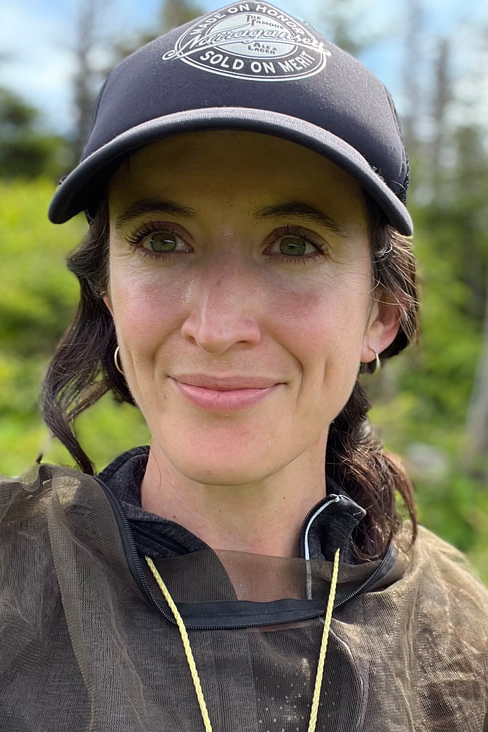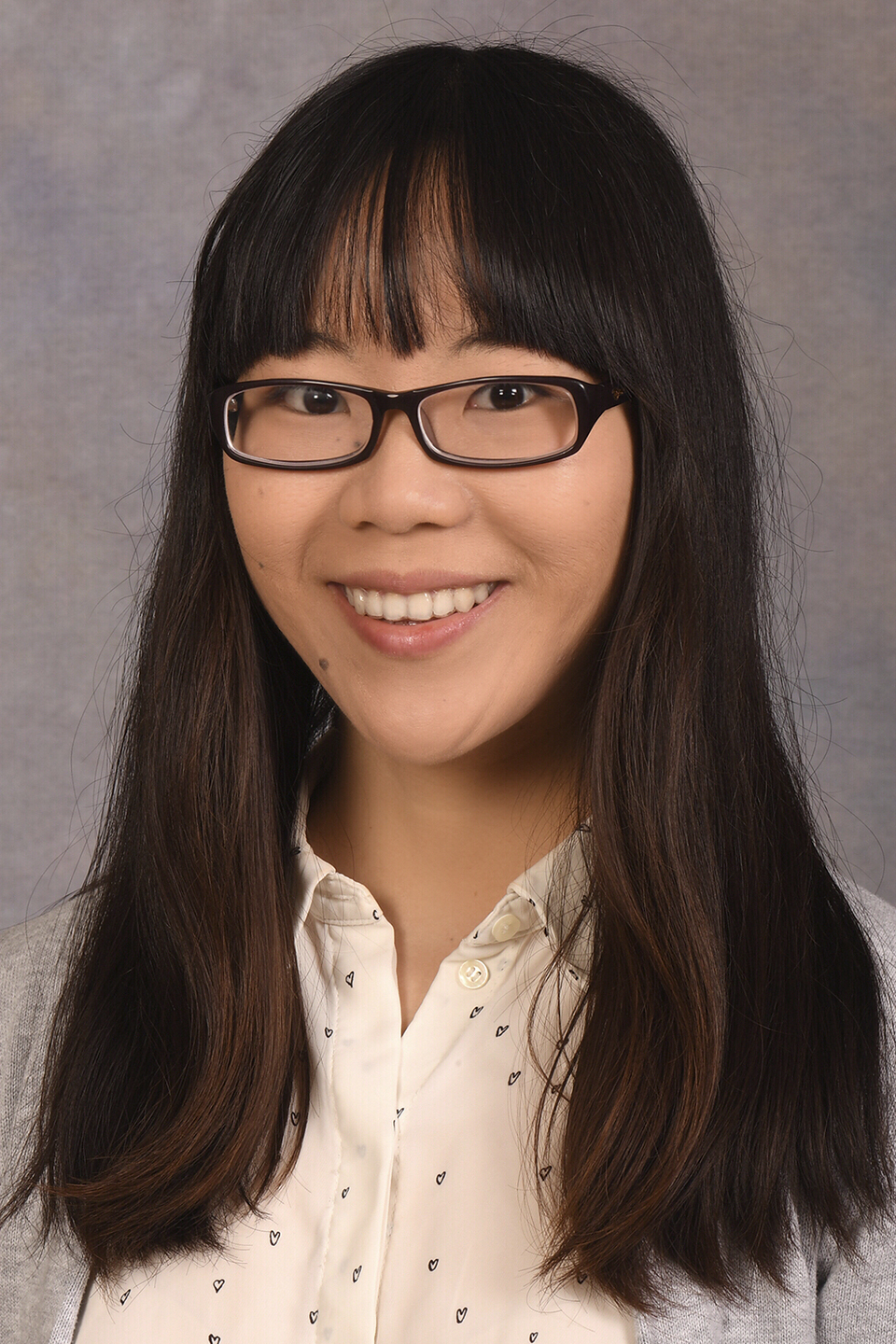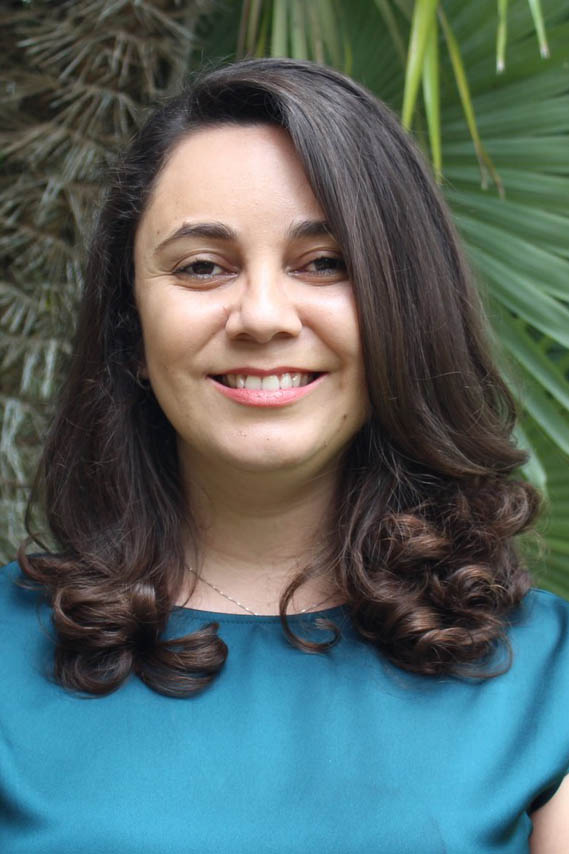
2024 PP Systems
Innovator’s Travel Award
Meet the 2024 Recipients
When will the 2025 Innovator’s Travel Award application become available?
PP Systems Innovator's Travel Award Criteria
- Be an active PP Systems user
- Have an accepted poster or talk at an upcoming conference in 2024 that includes the use of at least one of our instruments as part of the research to be presented
- Be active on social media (via your own lab blog, Twitter, Instagram, etc.)
- Submit a 2-minute video telling us a bit about yourself, your research, and why you believe you would benefit from this travel award in regard to your research
- Receive a written recommendation from your professor or supervisor
- Create a brief (one-minute) follow-up video about how they benefited from attending the conference
Each recipient receives:
- $1,000 to be used for travel expenses
- Opportunity to work with PP Systems on application notes and possible webinar related to your research
- Access to our scientific and technical staff
- Support and promotion of your research, poster, and presentations
Elizabeth Forbes, Ph.D.
Yale University
School of the Environment
Professor/supervisor: Oswald J. Schmitz, Ph.D.
Exploring rangeland zoogeochemistry at multiple scales to characterize animal impacts on ecosystem carbon | ESA 2024
Research
Soil carbon dynamics are conceptualized from the ground up, given the critical roles of plant and soil microbial communities. However, in rangeland ecosystems, the effects of large-bodied, vertebrate consumers are also significant. Laikipia Kenya’s savannas, where an intact community of wild herbivores remain and where pastoralism of domestic cattle has been practiced for millennia, are ideal systems to study the effects of mammalian community on belowground carbon. Large consumers are engineers of aboveground ecosystem structure, an understudied pathway by which they may also influence landscape scale carbon storage, and also the spatial and temporal heterogeneity of soil carbon dynamics.
The effects of large herbivores, and changes to their community composition, influences soil carbon storage and emissions dynamics across a rangeland ecosystem, and the development of high-resolution methods for measuring soil carbon respiration to capture the effects of animals on an ecosystem’s carbon cycle.
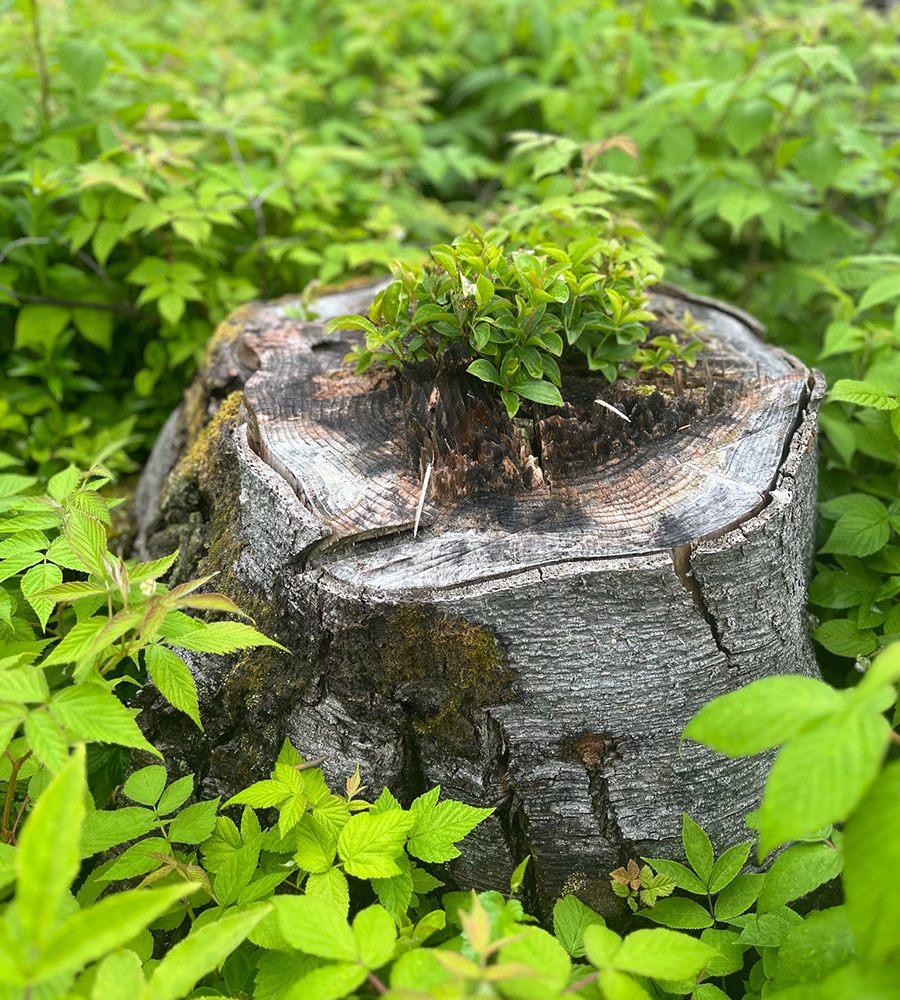
Yiyun Lin, Ph.D.
The Ohio State University
Department of Horticulture and Crop Science
Professor/supervisor: Chieri Kubota, Ph.D.
Research
Fully controlled indoor farming allows the production of superior-quality strawberries by providing optimal growing conditions. As strawberry growth, production, and quality can be largely affected by both genotype and environment, it is important to identify strawberry cultivars with characteristics specifically desirable for indoor farming. Twenty-five strawberry (Fragaria × ananassa) cultivars were selected and evaluated in a walk-in growth chamber. Strawberry cultivars with early production, high productivity, high light use efficiency, and low sensitivity to dormancy-inducing photoperiod were identified and great variations in fruit quality were found across cultivars. Correlations linked fruit production to plant morphological and photosynthetic characteristics, revealing the intricate sink-source dynamics in strawberry plants. Strawberries with higher photosynthetic rate per plant produced later harvest, while the productivity was greater. The information on strawberry growth and production from this study can assist indoor growers in cultivar selection and provide foundation for further research focusing on optimizing indoor environment to enhance the productivity and quality of premium strawberry cultivars.
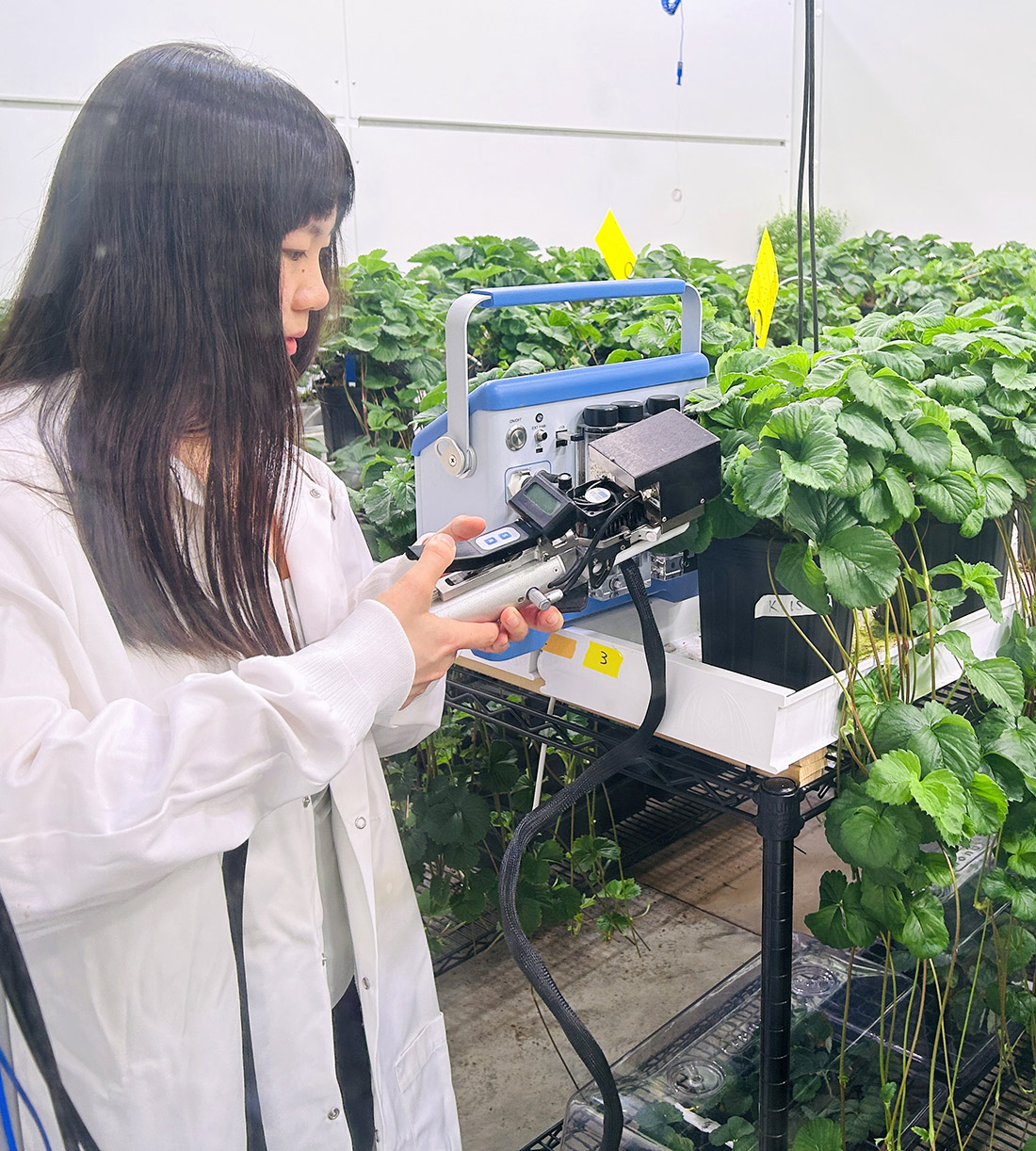
Application Video
Le Liu
University of Massachusetts – Amherst
Department of Biology
Professor/supervisor: Michelle Facette, Ph.D.
Research
Le Liu1,2, Michelle Jimenez1, Anastasia Andriyash1, Antonia Gray1, Paula Llanos2, Beth A. Cimini2, Michelle Facette1*
1Plant Biology Graduate Program and Department of Biology,
University of Massachusetts, Amherst, MA, 01003
2Imaging platform, Broad Institute, Cambridge, MA, 02142
Stomata, small pores on land plant leaves, facilitate gas exchange. Despite kidney-shaped guard cells being common, stomata exhibit diverse morphology. Subsidiary cells’ number, shape, and size vary. Opening stomata lets CO2 in but increases water loss. Plants with fast stomata opening may use water more efficiently. Grass stomata respond fast due to uniquely dumbbell-shaped guard and triangle-shaped subsidiary cell shapes1. Our research suggests subsidiary cells aid stomatal closure2. What features of guard and subsidiary cells optimize closure efficiency?
To tackle this question, we measured stomatal closure speed and visualized stomatal morphology across 29 maize inbred lines. To address this challenge of lacking high-throughput phenotyping methods, we developed a deep-learning model to precisely identify and segment guard cells and subsidiary cells. Comparison between hand-traced and model-predicted sizes revealed no significant differences in both guard cells and subsidiary cells, indicating the high accuracy of our model predictions. Subsequently, we utilized CellProfiler3, an open-source software for modular image analysis pipelines, to extract high-dimensional anatomical features from segmented cells. Our study unveiled variations in stomatal dynamics and morphology among maize genotypes. Subsequent analysis indicates these variations are genotype dependent. We aim to share our pipeline and novel research with the plant science community.
- Le Liu, M. Arif Ashraf, Taylor Morrow, Michelle R. Facette#. (2023) A receptor-like protein PAN2 is required for ABA-mediated stomatal closure via Ca2+ dependent pathway. New Phytologist https://doi.org/10.1111/nph.19379
- Gray A, Le Liu and Facette M#. (2020) Flanking support: how subsidiary cells contribute to stomatal form and function. Frontiers in Plant Science https://doi.org/10.3389/fpls.2020.00881
- David R. Stirling, Madison J. Swain-Bowden, Alice M. Lucas, Anne E. Carpenter, Beth A. Cimini & Allen Goodman. CellProfiler 4: improvements in speed, utility and usability. BMC Bioinformatics https://doi.org/10.1186/s12859-021-04344-9
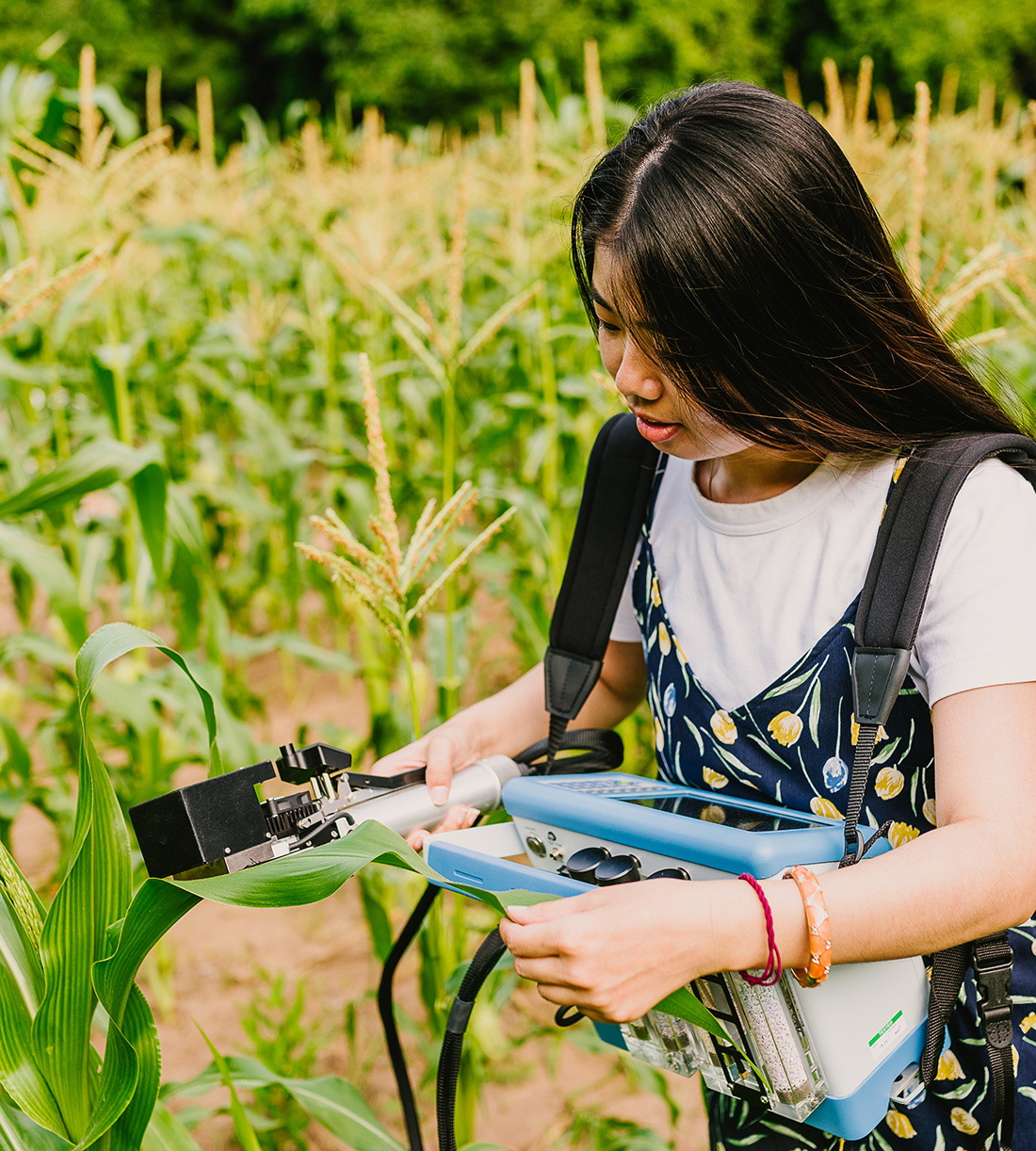
Patrick Milligan, Ph.D.
University of Nevada – Reno
Department of Biology
Professor/supervisor: Elizabeth Pringle, Ph. D.
Interactions with herbivores and mutualists experienced by mother trees drive physiological and epigenetic patterns in their offspring | ESA 2024
Research
Dr. Milligan’s research is focused on how ant-hosting plants adjust their photosynthetic parameters and transpiration in response to costs and benefits created by their ant symbionts. Tree-nesting ants can provide various levels of service to the tree (e.g., protection from herbivores, seed dispersal, pollination), but also extract different levels of resources from their host tree (in the forms of e.g., nectar, lipid bodies). His project has experimentally manipulated ant succession in a Kenyan savanna dominated by the ant-tree Vachellia (Acacia) drepanolobium, and uses a CIRAS field photosynthesis meter to monitor photosynthetic parameter adjustments throughout the ant succession process. In a collaboration with Dr. Bridgett vonHoldt (Princeton University), Dr. Milligan is also working to tie these physiological adjustments to patterns in DNA methylation, which is hypothesized to be a molecular mechanism that facilitates tree phenotypic plasticity.
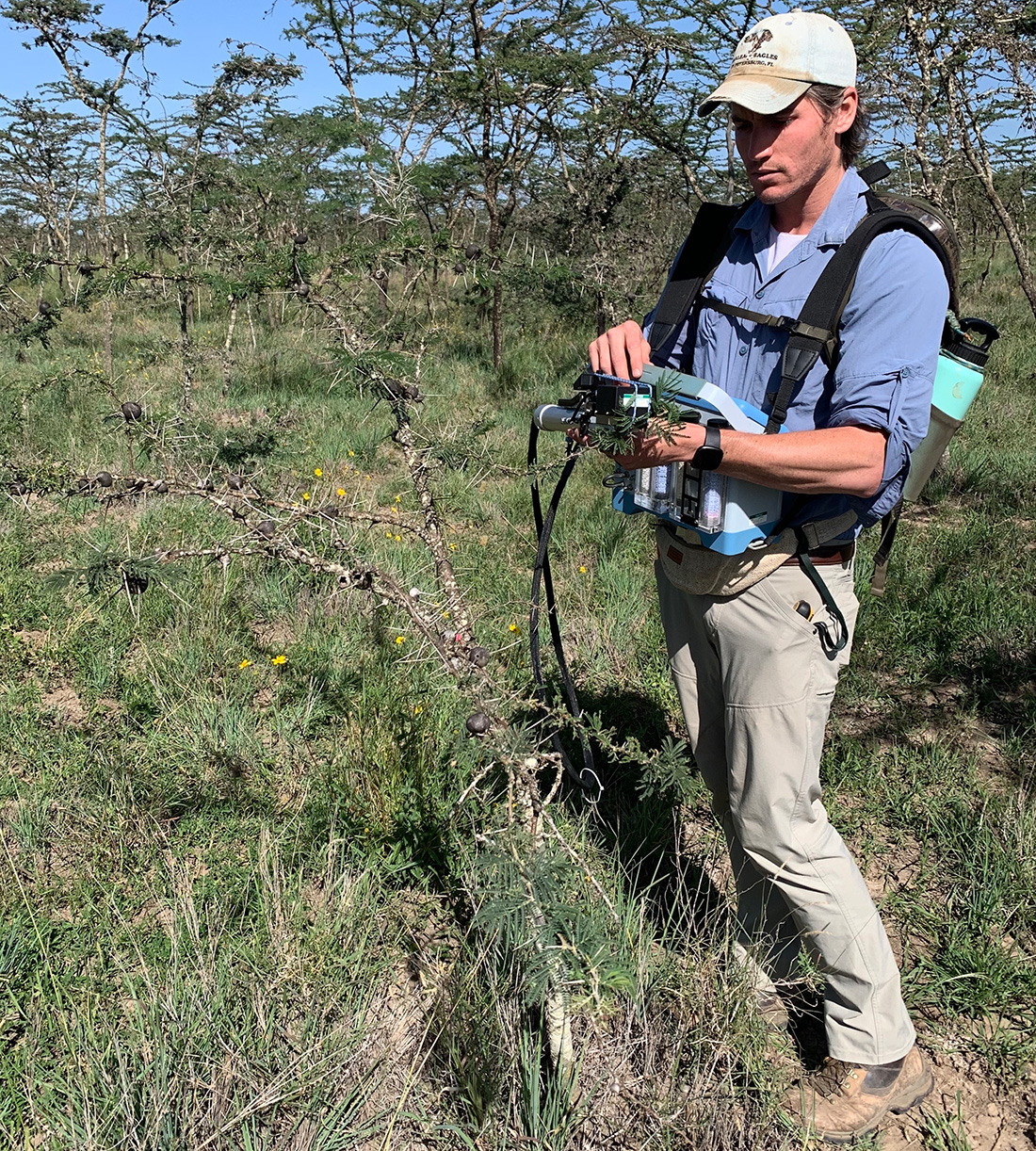
Application Video
Marlon Retana-Cordero
University of Florida
Department of Horticultural Sciences
Professor/supervisor: Gerardo Nunez, Ph.D.
Research
My experiment consists of determining the physiological and morphological responses to phosphorus deficiency of different varieties of southern highbush blueberries with different growth habits.
Our objective was to determine how blueberry plants respond when grown in a phosphorus-deprived solution. While many plant nutrition studies ignore gas exchange parameters, we studied the connection between phosphorus deficiency and carbon gain and loss. We established a greenhouse experiment with controlled conditions and measured several variables including photosynthesis, root respiration, carbon exuded by roots, enzymatic activity, leaf spectroscopy, fresh and dry biomass, root characteristics, and phosphorus concentration and content in the plants.
We designed and tested a whole-plant gas exchange system that uses two infrared gas analyzers (CIRAS-3 and CIRAS-4) to simultaneously measure root respiration and whole-plant assimilation. We have deployed this system in the study of blueberry phosphorus deficiency. This approach has allowed us to estimate the carbon cost of a nutrient deficiency, which represents a paradigm shift in our understanding of plant mineral nutrition.

Application Video
2025 PP Systems Innovator’s Travel Award
"*" indicates required fields
2023 PP Systems Innovator’s Travel Award Recipients
We are committed to continue to refine the role of instrumentation as a seamless extension of the thought process of every student of science, providing the freedom to focus on the valuable work to be done.
Suyun Nam
University of Georgia | Dept of Horticulture
Professor/supervisor: Marc van Iersel
Research
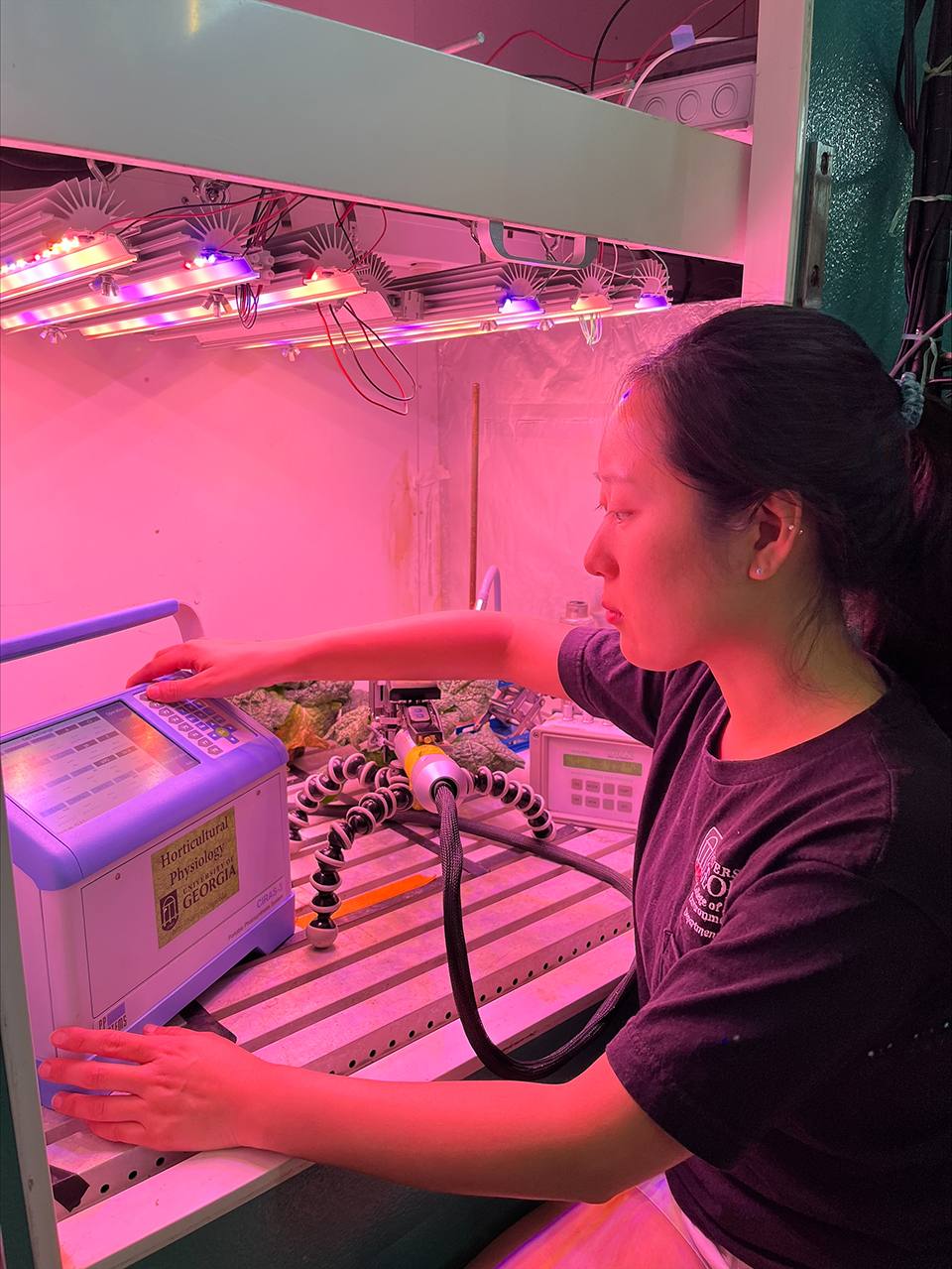
Application Video
Conference Experience
Aline de Camargo Santos
University of Florida | Dept of Horticultural Sciences
Professor/supervisor: Bruce Schaffer
Research
Salinity is a major cause of abiotic stress to crops, including papaya (Carica papaya L.), one of the most cultivated fruit crops in tropical and subtropical regions. Two experiments were conducted to assess the response of ‘Red Lady’ papaya plants to salinity stress. In both experiments, salt stress was imposed by adding different concentrations of Instant Ocean® to the irrigation water. In the first experiment, 5-month-old plants were subjected to electrical conductivity (ECw) levels in the irrigation water of 0, 1, 2, 3, 4, or 6 dS m-1 by manually irrigating them to field capacity every other day. To assess plant stress, single-leaf gas exchange [net CO2 assimilation (leaf-A), transpiration (leaf-Tr), and stomatal conductance of water vapor (leaf-gs)] was measured weekly for plants in each treatment. Plants were harvested after eight weeks and leaf, stem, and root dry weights were determined for all plants. Six weeks after treatments began, there was a 40-50% reduction in leaf-A, leaf-Tr, and leaf-gs for plants subjected to 6 dS m-1, whereas there was no significant difference in leaf gas exchange among any of the other treatments. There was no significant effect of ECw on leaf, stem, or root dry weights. A second experiment was conducted using a high-throughput automated plant phenotyping system to apply treatments and assess salinity stress. In this experiment, 3-month-old plants were exposed to ECw levels of 0, 2, 4, or 8 dS m-1 applied daily via in-pot drippers. Whole-plant transpiration (plant-Tr), root water uptake, plant water use, and whole-plant biomass accumulation were measured continuously by the phenotyping system. There was a decrease in plant-Tr of 13, 25, and 55% for ECw levels of 2, 4, and 8 dS m-1, respectively, compared to the control treatment. The salt treatment also affected root water uptake, with decreases of 40, 70, and 74% for ECw levels of 2, 4, and 8 dS m-1, respectively, compared to the control treatment. Plant biomass was reduced by 16% at the ECw level of 8 dS m-1, while the other treatments had similar biomass to the control treatment. Both experiments indicated that ‘Red Lady’ papaya can tolerate salinity levels of up to 6-8 dS m-1. Assessing salinity stress of papaya using periodic single-leaf gas exchange measurements or continuous whole-plant physiological measurements were both effective for assessing papaya responses to salinity.
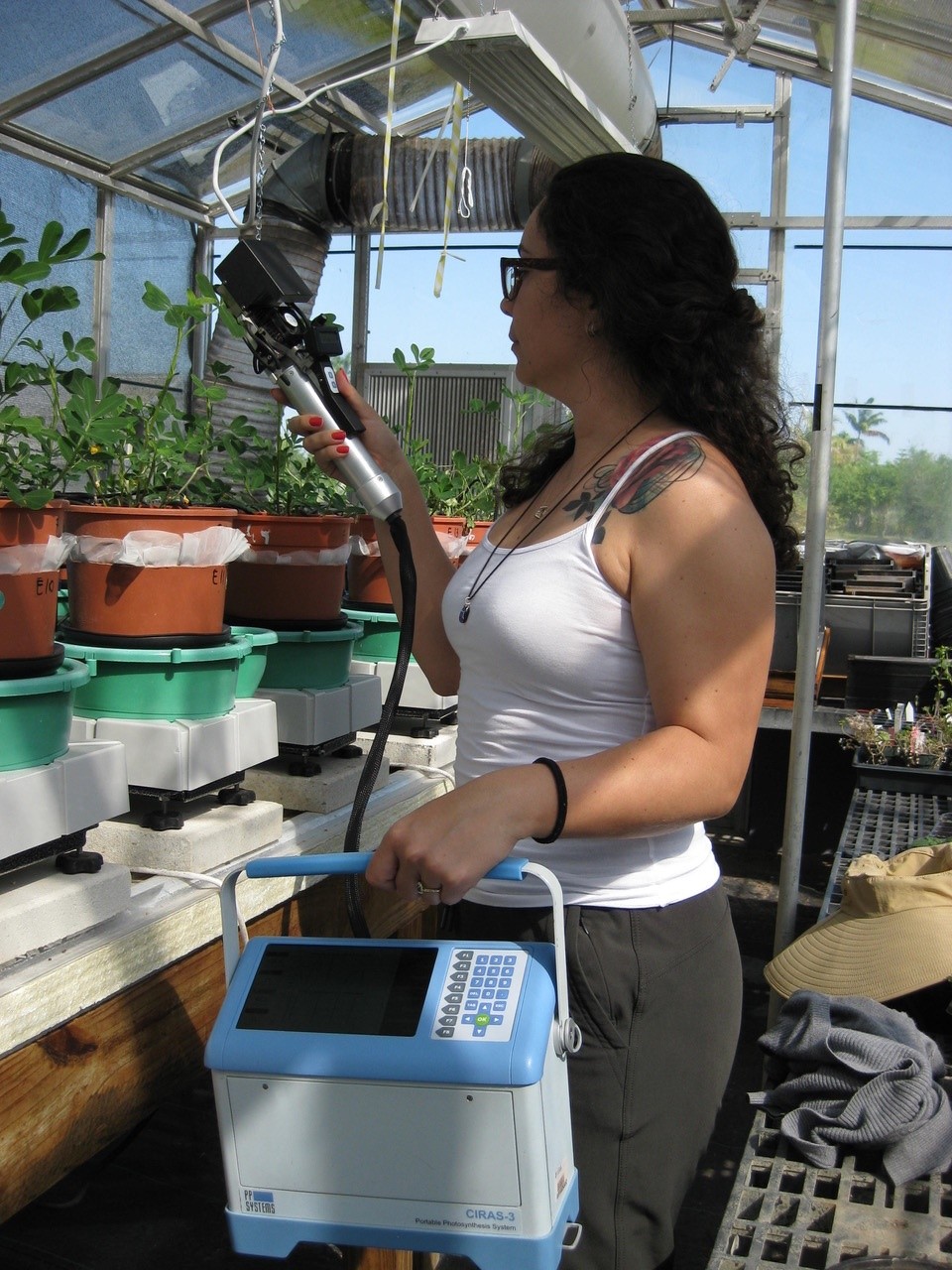
Application Video
Conference Experience
2019 PP Systems Innovator’s Travel Award Recipients

Jun Liu
University of Georgia | Horticulture Department
Professor/supervisor: Marc van Iersel
Green Light Benefit Photosynthesis at High Light Level | ASHS 2019
Research
Under our ultimate goal of improving profitability for controlled environment agriculture (CEA) by smarter lighting strategy, my research focuses on light quality of supplemental lighting.
There are many aspects of supplemental lighting that can be modified, for example, light intensity, photoperiod, and light quality. Optimized lighting strategy can help CEA growers reduce production costs, increase crop yield and quality, hasten or delay crop maturation time to meet market window, and overall increase profitability. Optimization of lighting strategy, however, requires an extensive understanding of spectral effects on photosynthesis and crop performance.
Part of my light quality research focuses on the benefit of green light on carbon fixation. Traditionally, green light is considered to be less photosynthetically active than red and blue light. However, green light can penetrate deeper into leaves and engage more cells for photosynthesis. Therefore it can be used more efficiently especially at high PPFD. To characterize the interactive effect of wavelength and intensity of growth lights on photosynthesis, I compared effects on photosynthesis of red, green and blue lights as well as red/green and blue/green mixtures at different ratios on ‘Green Tower’ lettuce (Lactuca sativa). At PPFD of 200 µmol m-2 s-1, red light and 80% red+20% green resulted in the highest photosynthetic rates, while blue, green and mixtures of these two yielded the lowest photosynthetic rates. At high PPFD (1000 mol m-2 s-1), red and green lights have comparably high photosynthetic rates, when blue light and its mixtures still have relatively low photosynthetic rates. Also, green light was efficient at up-regulating Rubisco activity.
In conclusion, green light is more effective at driving photosynthesis at high PPFD. This knowledge could lead to refined design of LED growing lights that will enhance the light use efficiency, cut back on energy consumption of CEA, help the industry increase profitability.
Application Video
Conference Experience
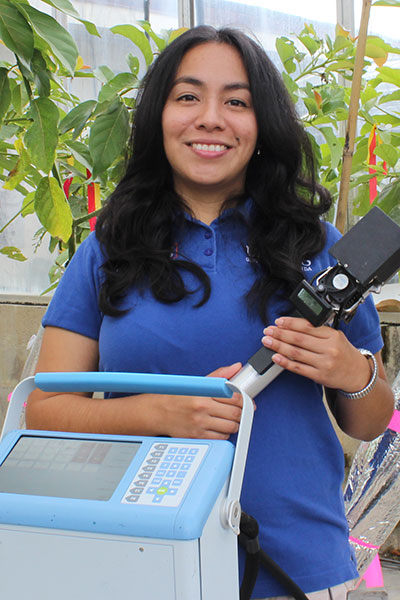
Raiza Castillo
University of Florida | Tropical Research and Educational Center
Professor/supervisor: Bruce Schaffer
Use of Stable Carbon Isotopes to Assess Photosynthetic Response of Redbay Trees to Laurel Wilt | ASHS 2019
Schaffer Tropical Plant Ecophysiology Lab
![]()
Research
My research involves assessing the effects of Laurel wilt disease as it relates to the physiology of avocado cultivars and other related tree species. Laurel wilt is caused by Raffaelea lauricola, an aggressive fungal pathogen transmitted by bark beetles. Since its first report in 2002, laurel wilt has caused the death of millions of redbay and has become a major concern to Florida’s avocado industry. Florida’s avocado production is based in avocados from the West Indian race or West Indian hybrids, which have been proven to be far less tolerant to laurel wilt when compared with the Mexican and Guatemalan race. Infected trees with laurel wilt display a variety of internal and external disease symptoms including wilted and necrotic canopy and sapwood discoloration. After infection, some plants exhibited increased cell permeability, alterations in water use and photosynthesis as well as histological changes like the formation of gels, gums, and tyloses that occluded the xylem. For this reason, the overall goal of my research is to understand the relative physiological and anatomical differences among different avocado cultivars and forest trees to identify cultivars that are the most tolerant to laurel wilt infection as well as to understand the basis for this tolerance. Physiological measurements include periodic determinations of net CO2 assimilation (photosynthesis), transpiration, stomatal conductance, chlorophyll fluorescence, leaf chlorophyll concentration, xylem sap flow, hydraulic conductance and stem anatomy among different seedling and clonal avocado. My last experiment involved the use of carbon isotopes to determine if the decrease in photosynthesis of plants with laurel wilt is caused by restricting CO2 entry into the plant through the stomata or if there are other physiological factors involved. I will be presenting my findings at ASHS 2019.

Rebekah Davis
University of Central Florida | Biology Department
Professor/supervisor: Chase Mason
Photosynthetic Variation Among Cultivated Sunflower | Botany 2019
![]()
Research
Cultivated sunflower is the fourth most important oilseed crop globally and exhibits a wide phenotypic diversity across the germplasm. Using a core set of twelve inbred lines that capture approximately 50% of the allelic diversity across cultivated sunflower germplasm collections, the CIRAS-3 portable photosynthesis system was used to measure rapid A/Ci curves, generating key metrics of photosynthetic physiology like maximum rate of carboxylation, maximum rate of electron transport, maximum assimilation rate, and CO2 compensation point. These measured photosynthetic traits will be used to ground-truth potential high-throughput proxies for these traits, including hyperspectral reflectance and chlorophyll fluorescence. We are currently assessing the utility of hyperspectral reflectance for predicting A/Ci curve-derived photosynthetic traits across a wider panel of sunflower germplasm. Given the contribution of photosynthetic performance to overall yield and growth, these proxies, if validated, would make for fast and easy tools for phenotyping photosynthesis with applications to molecular breeding. Finally, a high-density genetic map is currently being used to perform genome-wide association mapping to describe the genetic architecture of these descriptors of photosynthetic physiology in cultivated sunflower. I will be presenting my research at Botany 2019.
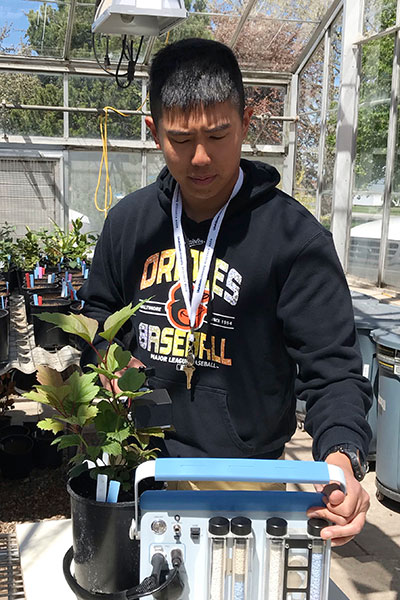
Ji-Jhong Chen
Utah State University | Plants, Soils and Climate Department
Professor/supervisor: Youping Sun
Comparing the Salt Tolerance of Three Landscape Plants Using Near Continuous Gradient Dosing System | ASHS 2019
Utah State University Center for Water-Efficient Landscaping
Research
My thesis research focuses on promoting the use of native plants for a water-efficient landscape. Developing sustainable horticultural practices for growing native plants in low-water-use landscapes will assist in water conservation and enhance environmental stewardship. I will use symbiotic bacteria to improve the adaptability and performance of two native plants [Ceanothus velutinus (snowbrush ceanothus) and Shepherdia rotundifolia (roundleaf buffaloberry)] in an urban landscape. These plants are actinorhizal plants and do not perform well in an urban landscape, which might be caused by the ineffective development of actinorhizal symbiosis with nitrogen-fixing actinobacteria (frankia). Frankia strains will be isolated from the soil and root samples of roundleaf buffaloberry and snowbrush ceanothus. The isolated frankia strains will inoculate roundleaf buffaloberry and snowbrush ceanothus plants that are propagated via cuttings and seeds with the hope to enhance their performance. Plant photosynthesis of inoculated plants in greenhouse or field environment will be investigated.
Additionally, I have investigated the salt tolerance of three common landscape plants [Hibiscus syriacus (rose of sharon), Physocarpus opulifolius (ninebark), and Spiraea japonica (japanese spirea)] using a near-continuous gradient dosing (NCGD) system. The innovative NCGD system allows researchers to evaluate a large number of plants for salt tolerance with multiple treatments, more flexibility, and reduced efforts of irrigation. The NCGD system delivered saline solutions at electrical conductivity (EC) levels ranging from 0.8 dS·m-1 to 6.4 dS·m-1. The salt stress negatively impacted plant growth and photosynthesis as EC levels increased. The salinity threshold defined as 50% loss of shoot dry weight was 5.4 and 4.6 dS·m-1, respectively, for ninebark and japanese spirea, however not determined for rose of Sharon which is the most salt tolerant species in the study. I am looking forward to presenting the detailed results of my research at the American Society for Horticultural Science 2019 annual conference in July 2019.
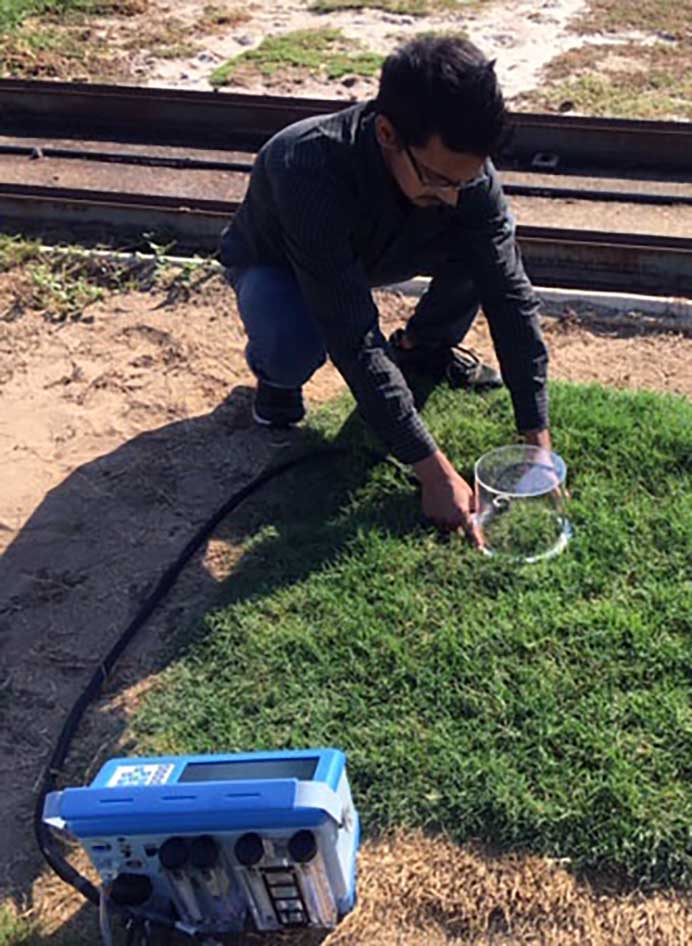
Krishna Katuwal
University of Georgia | Crop and Soil Sciences Department
Professor/supervisor: David Jespersen
Drought tolerance in seashore paspalum ecotypes collected from different climatic zones | ASA, CSSA, & SSSA 2019
![]()
![]()
Research
Turfgrasses are a vital part of human lives since they provide several services including recreational, aesthetic and environmental services. The turfgrass industry is one of the fastest growing segments of U.S. agriculture with an annual economic value of $35 billion (Huang et al., 2014). However, drought is one of the major constraints to turfgrass production that causes severe damage each year (Dai, 2013). There is a need to improve understanding of turfgrass drought tolerance mechanisms for its sustainable production. The objective of our study was to enhance understanding of turfgrass drought tolerance mechanisms and identify drought tolerant turfgrass cultivars using physiological and molecular approaches. Fifteen genotypes of seashore paspalum were grown under two different water treatments: well-watered and water-stressed for 20 days. They were assessed using morpho-physiological parameters including gas exchange parameters measured using CIRAS 3 to identify drought tolerant and sensitive genotypes. Identified drought tolerant genotypes had greater photosynthetic rates, osmotic adjustments and leaf water use efficiencies compared to sensitive genotypes after drought stress treatment application. However, transpiration rates and stomatal conductance were lower in tolerant genotypes compared to sensitive ones indicating better ability of tolerant genotypes to conserve water by stomatal regulation under drought stress. Identified drought tolerant and sensitive genotypes will be further grown under fully watered and water stressed condition for proteomic and metabolomic analysis in the future. Leaf and root samples will be used to extract proteins and metabolites and extracted proteins and metabolites will be identified using mass spectrometry coupled with protein and metabolite databases. Identified proteins and metabolites will be compared to determine their differential expression pattern among seashore paspalum genotypes. Greatly expressed proteins and metabolites might have involved in improving drought tolerance mechanisms of drought-tolerant seashore paspalum genotypes.
I will be presenting my research at the 2019 annual Crop Science Society of America meeting.
